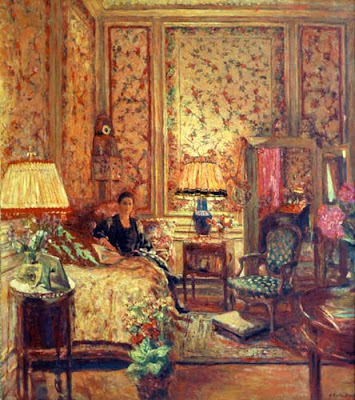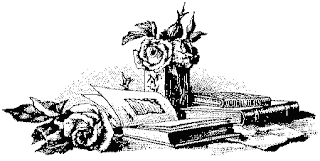by John Ciardi
I.
A frightful Scowl met an Owl sitting in a tree.
The Owl said, "Who?"
---If it was you
who answered, "It is me,"
Then hide your face. You're in disgrace.
And the next time you reply
to a bird in a tree
Don't say, "It is me."
Say, properly, "It is I."
II.
People who say nooz for news
Must think that kittens' cries are moos.
Kittens, properly, say mew,
Rhyming it, properly, with you.
.......................................................................
Copying
Now that you've had your grammar lesson from one of our favorite poets, sit back, relax and get ready for our simpler, gentler ways to learn grammar and the art of writing. Here's how we do it. After reading Benjamin Franklin's autobiography, I realized something that I later heard some homeschoolers say -- that the best way to learn to write, is to copy other great writers! Aha! So for our first language arts lesson, COPY! When the little ones learned to sit at the table with us and "do their lessons", they began to copy everything they would see their older brothers or sister writing -- numbers, letters, words, sentences. This is our first introduction to the language arts lessons. The children learned to copy simple words or sentences and soon they copied paragraphs from Bible verses, poetry, or excerpts from good books. They copied simple recipes, grocery lists for mom or a list of birthday wishes. All of this led them to understand that writing was something that people do every day and that it is very important. I insisted that our children write something every day.
Dictation
I found that not all of our five children learned in the same manner. Some could copy anything they saw, and some lost their place on the page and skipped things. Although I required copying, I found that dictation worked better for some of them. I did the same as for copying, only I read aloud the poem, sentences, or verses and then they would write them down in their best writing. We strove for neatness, accuracy, good spelling, good punctuation, and capitalization. I used dictation for the older student. I wouldn't ask a first grader to take a dictation when he's hardly learned to read. I would however, ask my 3rd or 4th grader to take a dictation if I thought he was able to spell most of the words. I had the child first read through the poem or excerpt himself and then take the dictation, trying to hear where the periods would go. After taking the dictation, I read it through again while the child checked it over himself, looking his paragraph through for any mistakes. When the child thought he had a good copy, he would check it against the original copy to see how he did and make any corrections necessary.
Spelling Lists
Often we made customized spelling lists with words which were missed in the writing lesson. At times I will added other words that were spelled similarly to the words missed. For example: If the word "patch" was missed, I might also add the words catch, fetch, and stitch to the list of spelling words. When I felt that the child had mastered his list, we began anew. If there was a troublesome word left, it was added to the next week's list.
Variety
I liked to make sure that when the children were writing, that they were writing things that they were interested in. I often let them pick their favorite part of the book they were reading for a copy or dictation. They might choose to write their favorite cookie recipe into their copybooks or write down instructions on "How to Make a Corn-husk Doll." Maybe your little boy needs a list of tools and materials to build a bird feeder. When children are interested in writing, they are so much more willing to write. And to me, this is the goal of writing -- to have the "want to" or the "need to."
One year I had each of our children (who were able to write) copy or make up instructions. Our daughter copied the Karen Andreola's "How To Make a Corn Husk Doll" instructions. Our middle son made his instructions on "How to Make an Ant Farm" which he later used for a 4-H demonstration. The eldest boy wrote instructions on "How to Change Oil in Your Vehicle." Do you see how practical these "writing lessons" were? They were not only of special interest to each individual child, but were useful as well. The children usually included hand-drawn pictures to go with their instructions.
Since we had four boys in our family, I know that not all little boys have time or patience to sit still and write. Our boys tended to wiggle lots and bounce their legs around and tap pencils on the table and look out the window and make car or animal sounds. Does this sound familiar? These are just a few more reasons to give your children a reason to write.
One son loved animals and decided that he'd like to be like Teddy Roosevelt and keep a book of all the animals that he studied so most of his writing lessons were about animals. Often these were dictations from books he had read on a particular animal. This boy did better with dictations, so most of his writings happen in this manner.
One son wanted to draw pictures of horses and animals constantly. He kept a folder of all the horses he drew of various breeds and kinds, and he gave each picture a name. Just the fact that he wrote a title above his drawings or a little sentence or two on the back describing it, shows how simply language is learned. He was a first grader when he began this project.
Our kindergarten student found very little time to write. He'd rather play Legos or make airplane runways with dominoes. I could get him to play with letter tiles and make short words with them. Sometimes I had him copy a word or two from his letter tile words. At other times he would want to write a letter to someone or write a story. At these times, I took dictation FROM him and copied it down. He loved to hear me read aloud his own stories over and over. Often he would color pictures to go with his stories and make a simple book by stapling all the colored pages and dictation bits together. This was the beginning of a child making sense of language.
In my humble opinion, I think that children under the 5th grade level, do not need any more language arts than what I have mentioned thus far. They learn so naturally to put periods at the ends of sentences, to capitalize proper names, to start sentences with capital letters, to spell and become familiar with the written language. While young children are learning so many new things -- reading, writing, and simple math, I feel they do not need the burden of formal grammar lessons.
I really do like the book You Can Teach Your Child Successfully by Ruth Beechick. In her book, she has many sample lessons for copying and dictation. When I discovered this method, I first used the examples directly from the book and had great success. Then I learned to do the same things with the very books and subjects we were studying on our own. I highly recommend this book for all subjects, but particularly for the language, spelling, and writing sections. I also like her book called Language and Thinking For Young Children for children ages 4-8. There were many fun exercises (especially the manners section) which our entire family did together! It was a very gentle introduction for young children into language arts.
All through our children's school careers, they wrote something practically every day. Some of the kids liked to keep a daily journal. Some didn't. When they were in their high school years, they continued the practice of copying excerpts from their reading just because they liked to. As an adult, I find myself copying lots of things from the books I read into journals. I have a book I call my Book of Favorites, and in it, I copy down favorite quotations, funny anecdotes, excerpts from books, and verses. Anything that tickles my fancy. All this to say, writing lessons do not have to come from a workbook or textbook. They can come from necessity, from practical needs, or from the depths of a creative mind and most often, these are the most meaningful and very best lessons of all.














